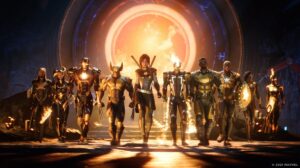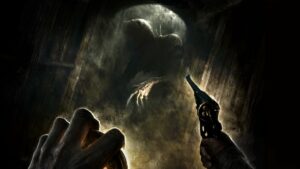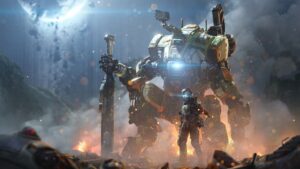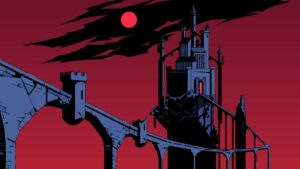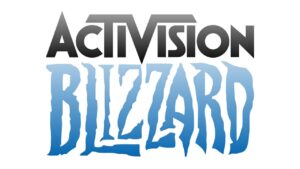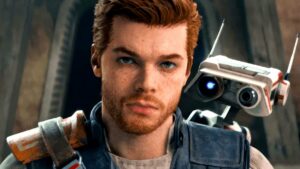While videogame sequels have never quite gained the erratic reputation of their respective cinematic experiences, there’s always a fear that a follow up won’t quite hit the heights of its predecessor. Not so Electronic Arts’ and Visceral’s Dead Space 2, ten years old this year and rightly regarded as one of the finest sequels of its generation.
Having survived the many trials and dangers of the first game, engineer Isaac Clarke awakens three years later on the Sprawl, a huge space station in orbit around the Saturn moon of Titan. Now in possession of a voice, Clarke is soon knee-deep in necromorphs as another outbreak of the undead creatures threatens to engulf the station. Throughout the first few hectic and horrific levels of Dead Space 2, the player guides Clarke across urban areas and the headquarters of the shady Unitology religion.
Meanwhile, lurking in the background and often visible to an alert gamer is the formidable planet cracker spaceship of the first game, its spiky angular shape haunting Isaac as he seeks to escape the necromorphs once more. “Very early in the game you can see the Ishimura parked up out there,” says Ian Milham, Visceral’s art director on Dead Space 2 and the driving force behind the game’s most famous level, chapter ten. “And y’know, we’re not hanging a lantern on it so it’s so literal. But we wanted to plant that seed, like, ‘oh man, are they gonna make me go back there? That’s going to be terrible.’ That was the idea, to spend the first part of the game hyping it up.”
As art director, Milham was in charge of art delivery, from evaluating concept art to representing the finished work to the rest of the Dead Space team, and the sequel soon found itself in a unique position in terms of personnel. “A significant portion of the [Dead Space] team left to form Sledgehammer,” explains Milham. “So we loaded up with a bunch of really great new talent because people thought it would be cool to work on a sequel.”
As one of the remaining people who had worked on the original Dead Space, Milham became involved in creative continuity and maintaining the spirit and themes that made the first game such a hit. The creation of chapter 10, Déjà vu On The Ishimura, was partially borne out of necessity, as he explains. “We had a certain number of chapters to make, and our idea was not to allocate resources to them equally, because you really want to blow out some of the early stuff, or in some cases you want to go really far with the look, like in the Unitology church, which is not particularly shared elsewhere. So it’s quite expensive to make in terms of art and, if I’m being frank about it, it means you need some really cheap levels.”
The objective was to come up with a mid-game level that felt like it was sufficiently advancing the story, while resonant, interesting to the player, yet light on art budget. Not too much to ask for. “The idea was to make a whole level that didn’t feel cheap, but only had about 15% new content from an art perspective,” says Milham. The logical solution was to set a level within an area that had already been explored by Isaac Clarke – in the previous game. “I pitched going into this area that had been cleaned up, or was in the process of being cleared, under UV light. Then I pitched another idea, about setting up, paying off and then surprising the player based on expectations in a way that a lot of single player games are not doing.”

In the company of CEC employee Ellie and the deranged scientist Nolan Stross, Isaac attempts to gain access to the government sector of The Sprawl, location of the mysterious Marker. The station’s administrator, Hans Tiedemann, stands in their way and has detached the area from the rest of the city. With the rail line severed by the solar array, Isaac has only one option left to him: his erstwhile nightmare, the USG Ishimura, which has been lurking on the periphery of his vision since the start of the game, contains gravity tethers which can be used to repair the line.
Upon entering the Ishimura, it’s evident there’s been a considerable effort to clean her up, with warning signs and hazard tape placed throughout. The player can’t help but hold their breath as they enter: what further terrors await them at a scene which remains potently fresh in their memory? “We felt like if we went back to the original ship we would get a lot of re-use and also inherit a lot of expectation,” says Milham. “People who had already played Dead Space would have the expectation that something was going to happen. That’s a rich fertile ground for playing with those expectations. Rather than trying to hide the fact we were reusing something, we tried to embrace it.” The result is a nerve-jangling trawl through some of Dead Space’s most haunting locations that look similar, but not quite the same.
It plays out a little like this. Isaac enters the original airlock and boarding area of the Ishimura. Nothing happens. Isaac descends in an elevator. Nothing happens. Isaac investigates those notorious toilets. Again, nothing happens. Isaac finds the computer in the flight lounge. Nothi- oh, you get the idea.

“We knew everyone would think, ‘oh man, that’s where this whole thing started – that’s gonna be an absolute gauntlet’,” laughs Milham. “So I said, what if it isn’t? What if we just held off from doing that for as long as possible, make people soak up the anticipation of something happening for as long as we could get away with?” By the time Isaac finally – and inevitably – encounters a necromorph, the player’s nerves have been frayed to the limit. Much of this is achieved through art and gameplay but as Milham generously notes, there’s another important aspect at work here.
“I always feel like art got a lot of credit that the audio department should have got,” he says. “Half of what people perceive as great graphics and atmosphere in the Dead Space games is the audio. The audio team is like the drummer in a band, no-one really credits them, but if it’s off the whole thing sucks. They rarely get the chance in the spotlight, but ironically any time the drummer has a solo, the crowd goes wild. The return to the Ishimura was our audio team’s drum solo.”
Chief ‘drummer’ was Visceral’s audio director, Andrew Boyd. “We were able to re-use some sounds,” he explains, “and notably all of the music in [chapter ten] was from the original game. But overall, it was more about achieving a particular effect rather than any kind of production economy.” Interestingly, Boyd associates the mood and other parts of this particular chapter with its protagonist’s own mental health. “Right near the beginning of the level, Isaac says ‘I’m going to have to go down to engineering.’ The next few minutes of gameplay are literally him going down: down elevators, down ramps, down stairs.”
With the entire game essentially a descent into the tortured psyche of Isaac Clarke, here it’s made manifest as the engineer delves into the depths of the Ishimura and thus his own angst-ridden memory. “If you listen to the ambience and music as he goes down, it parallels his descent,” reveals Boyd. “There are about a million lockers to open and crates to smash, which kind of distracts from the effect, but it’s there if you listen for it!”

This journey and the balance between reality and imagination is succinctly demonstrated in one scene. “There’s a jump scare moment when you think the big tentacle enemy from the first game is back, only to have it vanish as quickly as it appeared,” says Boyd. The sounds of this attack are identical to the first game, wrapped up in the hallucination effects of the sequel. “The player is left a little shaken from the momentary feeling that they were about to enter a hard combat. They’re also left uneasily wondering, can Isaac even trust his own experience?” Or, as a corollary, can the player?
Opinion on the direction of chapter 10 was not always unanimous. Milham in particular fought a continual battle to maintain the level’s ‘less is more’ ethic. “People would say, ‘this isn’t scary, make something jump out!’ There was lots of back and forth and pressure to add stuff. I guess it was pretty cheeky to have a level that’s mostly reused from the first game, and then put no enemies in it!”
It wasn’t just the first ten minutes that attracted controversy – the breakdown of locations that would be visited by Isaac during the chapter also incited considerable discussion, as Milham recalls painfully. “There was a big fight about whether to do a ‘greatest hits’ or something more geographically consistent.” With the latter concept a big pillar of the original Dead Space, many of the dev team wanted the level to play out logically.
The former won out, as Isaac finds himself in several iconic areas, usually where something nasty lurked. “That’s what ended up winning because ideally we wanted to warp you around to the places which had the richest set of expectations,” notes Milham. The finest example of this notion is the quarantine room, an enclosed and inescapable area which is certain to trigger shivers in even the most robust Dead Space veteran. Milham sports a cheeky grin when I recount my recent experience with this particular section. “Ha! You remembered the previous time, when it was a really big and close fight? This time the doors just close… and then they open up.” The grin widens to a devilish smile. “And then we get you on the way back!”
The evidence of an experienced team, backed with fresh enthusiasm is everywhere in chapter ten. The audio logs, reflecting different phases of the poor workforce left to clean up the mess of the previous game, help build up the dread in a low-cost and non-location dependent fashion. And humour, so often used as a contrast to horror in movies, is deployed effortlessly, most notably as Isaac travels through the Ishimura via its tram system.

‘They’re swarming through a hole in the medical deck. At least you won’t have to go through there.’ Ellie tells the engineer just before the train stalls and its tannoy issues a foreboding warning: ‘Unexpected obstruction ahead. Shutting down. Welcome to the medical deck.’ Now it’s my turn to grin as I ask Milham how the gag came about. “You get to a certain part in the dev process where you can see it – we were always gonna go to medical – and it was a return to the theme of expectation. It was fun to do it in a quick time scale. It was like, ‘oh man, you think it’s bad where you are? It’s really bad over here.’ And then immediately make you go there!”
With the necessary location hits logged, Isaac is thrust towards his next destination via an escape capsule inside the Ishimura’s vast bridge area. It’s an abrupt ‘magic door’ end to a fantastic section of video gaminGetting you on the way back in decontaminationg that remains one of the finest pieces of horror design of the last twenty years. “Before it came out, I had no idea if [chapter ten] would work,” muses Milham. “I’m still shocked that it’s one of the more popular levels in the game to be honest.” For Andrew Boyd, while feeling that the audio design in the game remains underrated, it was the chance to influence the player’s mood to such an extreme level that still resonates today. “It’s part of what many of us love about the discipline: being able to get under the player’s skin, maybe without them even noticing. Playing Dead Space 2, a player may not realise they were so creeped out because of the sound – but I knew it.”
For many gamers (and indeed reviewers, ourselves included), the reduction of Isaac Clarke to a glorified and mute errand boy in the first game was a huge sticking point. Given a voice in the sequel, and able to direct his own destiny – well, up to a certain point, given events – the real and mental journey of this emotionally fragile protagonist is never more pronounced than during his cathartic revisit to the USG Ishimura. And as juicy as the UV bloodstains and restrained gameplay are, it’s the combination of these facets with the audio design that really accentuates the chapter.
It therefore seems appropriate that the final observation should go to the game’s audio director, Andrew Boyd. “Beyond the audio logs and obvious dialogue, pay attention to the use of voice in the level,” he says. “The way Stross’ voice rambles in the background of Ellie’s comm, becoming more threatening. The voices coming from the broken-up video screens, the cold matter-of-fact tone of the ship’s announcements. Even the creepy spectral whispers that appear throughout – it’s all just a little more intentional and directed in this level.” Spooky, intense and unusual in its design, Dead Space 2’s Chapter Ten is one of those pieces of gaming that you never quite forget. Wait up. I think I heard something.
My thanks to Ian Milham, Andrew Boyd and Chuck Beaver for their time and help.
Source: https://www.eurogamer.net/articles/2021-05-07-dissecting-dead-space-2s-most-memorable-level
- '
- "
- Absolute
- access
- All
- Announcements
- AREA
- around
- Art
- Arts
- audio
- Battle
- BRIDGE
- build
- Bunch
- cases
- charge
- church
- City
- coming
- company
- content
- controversy
- Creative
- credit
- Credits
- dead
- delivery
- Design
- Dev
- Director
- driving
- Early
- economy
- engineer
- Engineering
- Enters
- events
- Experiences
- Fashion
- Finally
- finds
- First
- flight
- follow
- form
- fresh
- fun
- game
- Gamers
- Games
- gaming
- Gauntlet
- Government
- great
- grin
- Guides
- Health
- here
- Hide
- hold
- How
- HTTPS
- huge
- idea
- influence
- involved
- issues
- IT
- jump
- Level
- light
- Line
- location
- Long
- love
- man
- medical
- Mental health
- million
- mood
- Moon
- Movies
- Music
- Near
- Notion
- open
- Option
- Other
- outbreak
- Pay
- People
- Personnel
- perspective
- Pillar
- planet
- player
- poor
- Popular
- possession
- pressure
- Production
- protagonist
- quarantine
- Rail
- RE
- Reality
- religion
- Resources
- REST
- Scale
- seed
- set
- setting
- shared
- shocked
- Signs
- Skin
- So
- solar
- Space
- space station
- spend
- Sports
- Spotlight
- start
- started
- system
- Talent
- tells
- The Voices
- theme
- time
- Trust
- urban
- Urban Areas
- us
- veteran
- Video
- vision
- Voice
- VOICES
- wait
- WHO
- within
- Work
- workers
- Workforce
- year
- years


